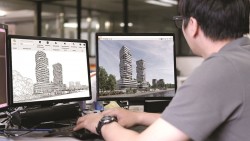Jackie Maginnis at the Modular and Portable Building Association (MPBA), has been involved in construction related businesses for over 37 years and has been its Chief Executive since 2005 – how has the perception of modular and portable buildings in the UK changed since then?
Modular solutions now make up 60- 70% of the offsite market, and arguably form a method of construction that is experiencing an entirely different growth trend to that of panelised offsite approaches. Market intelligence from 2018 – 2019 provided evidence of a turnover in the modular and portable building sector of nearly £3,000 million. This figure excludes the turnover from the major players who have recently entered the volumetric modular arena: including banking giant Goldman Sachs, investing £75million into modular housing business, TopHat and Sekisui House partnering with Homes England and Urban Splash. But the largest deal by far was revealed by ilke Homes’ involving a £100million agreement with Places for People.
The surge in demand for modular technology has gone hand-in-hand with an increase in investment which in turn drives innovation. At the core of offsite manufacture, Design for Manufacture and Assembly (DfMA) protocols and Building Information Modelling (BIM) technology empowers optimal configuration of offsite solutions by digitally connecting multi-discipline teams from the beginning of the concept design right through to the development process and beyond.
DfMA means buildings are conceived for offsite manufacture and assembly onsite. While BIM facilitates early design detail and three-dimensional design information, minimising the risk of errors by eliminating the time-consuming process of translating engineers’ information into cutting lists and assembly drawings. BIM also facilitates the optimising and testing of designs in virtual and pre-production environments.
A key factor in recent years has been the Government advocating more adoption of modular technology. Since the publication of Mark Farmer’s report, ‘Modernise or Die’ in 2016 – Westminster has been more outwardly supportive and increasingly have supporting evidence to underpin their involvement and investment. By far the greatest benefit to our industry is having a guaranteed project pipeline. This gives manufacturers the confidence to invest in research and development to advance modular technology as well as finance larger factory facilities, machinery, robotics and digital technology to constantly evolve and advance the industry.
Technology is ever evolving, and the offsite industry is now integrating BIM and digital design specifications with Enterprise Resource Planning (ERP) and Material Requirement Planning (MRP) to improve accuracy, productivity and material usage. This technology permits manufacturing simulation and visualisation, clash detection and virtual onsite assembly modelling/programming, which can be enhanced using augmented and virtual reality. The demand for customisation has also led the industry to develop methods for adaptation during the mass production process to meet individual requirements. These modules can be delivered to site pre-fitted with electrics, plumbing, heating, doors and windows, thereby reducing the onsite building programme and accelerating the overall construction process.
Sophisticated & Technical Developments In her report ‘Building a Safer Future’, Dame Judith Hackitt highlights the need for a system-based approach with a golden thread of information running through the lifecycle of each project from concept to completion. Central to the concept is guaranteeing the traceability and availability of project data and all decisions relating to the design, construction, safety performance and maintenance of the building – which not only enhances building safety but alleviates contractual disputes. With modular construction all data can be validated and coordinated as part of a structured process, which helps provide accurate and reliable information for clients at the point of handover. Modular construction helps ensure client satisfaction and product assurances through the certainty and quality embedded into the build process.
The MPBA was founded in 1938 and its role has changed hugely over the years to be the organisation it is today. When I joined the MPBA it was very much a meeting place for like minds, it was my ambition to drive the association where it could make a difference. We now have a clear remit and objective which is to represent the interests of our members and the industry sector. Working with directors who are also members makes this an association for the industry, run by the industry.
We collaborate with specialist technical advisors to enhance innovation in the design and manufacture of modular buildings. We have also secured a ‘seat at the top table’ and now influence the national construction agenda at a governmental level and promote the benefits of volumetric modular technology nationwide. Looking to the future, as with many sectors, to continue to grow we need new innovative people to join our industry. With the specialist nature of what we do ‘off the shelf’ training does not fit the bill – so we are developing training to meet our industry’s needs which we will announce later this year. We are now far removed from the stigma associated with the ‘prefabs’ of yesteryear and I am very proud to play a major role in this transition.
For more information visit: www.mpba.biz









